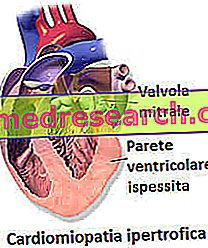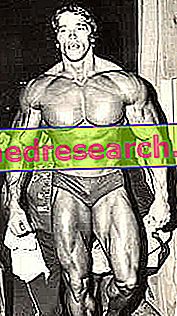Generality
Hypertrophic cardiomyopathy is a myocardial disease, characterized by thickening of the walls of the ventricles and a reduction in their internal cavities.

Figure: Illustration of a heart affected by hypertrophic cardiomyopathy. From the site en.wikipedia.org
In such circumstances, the pumping action carried out by the heart is impaired and the blood available to the tissues is scarce.
Hypertrophic cardiomyopathy always involves the left ventricle of the heart, while the right is affected only in rare cases.
Generally, the cause of the disease is to be found in a genetic defect transmitted from parents to children.
When present, the main symptoms are dyspnea, chest pain, cardiac arrhythmias and edema in various parts of the body.
Diagnosis requires several tests, some of which are invasive.
A person with hypertrophic cardiomyopathy cannot heal, but with the right treatments can significantly improve their health
A brief reference to the anatomy of the heart
The heart is a hollow organ, composed of four contractile cavities: two are on the right and are called right atrium and right ventricle ; the other two are on the left and are called left atrium and left ventricle . Through the atrium and the right ventricle passes the non-oxygenated blood, to be pumped towards the lungs; through the atrium and the left ventricle, on the other hand, passes the oxygenated blood to be pumped to the various organs and tissues of the body.
The pumping action is guaranteed by the muscular structure that constitutes the four cardiac cavities, called as a whole myocardium .
To regulate the flow of blood between the various compartments and between the heart and blood vessels, there are four valves, also known as heart valves .

What is hypertrophic cardiomyopathy
Hypertrophic cardiomyopathy is a myocardial disease, characterized by an enlargement of the cells that constitute it and a thickening of the walls of one (the left) or both ventricles.
In these conditions, the ventricular cavity or cavities are reduced and the pumping action carried out by the heart is less effective. As a result, the proportion of blood sent to the various organs and tissues of the body will also inevitably be compromised.
WHAT IS A CARDIOMYOPATHY?

Figure: representation of cardiac alterations in various types of cardiomyopathies. From the site: merckmanuals.com
The literal meaning of cardiomyopathy is: heart muscle disease . It is not by chance, therefore, that cardiomyopathies represent a series of pathologies that affect the myocardium and that are characterized by an anatomical modification of the latter. This anatomical alteration, as happens in the case of dilated cardiomyopathy, is followed by an alteration on a functional level: the heart, in fact, becomes weak and less effective in its blood pumping action.
There are at least two criteria for classifying cardiomyopathies.
The first criterion is based on the place of origin of the problem and distinguishes primary cardiomyopathies, in which only the heart is affected, from secondary cardiomyopathies, in which the problem of the myocardium depends on pathologies of other organs or particular situations.
The second criterion, instead, is based on the characteristics of the alterations that the myocardial structure undergoes and identifies four types of cardiomyopathies:
- Dilated cardiomyopathy
- Hypertrophic cardiomyopathy
- Restrictive cardiomyopathy
- Arrhythmogenic cardiomyopathy of the right ventricle
MYCARDIC CELL DISORGANIZATION
Hypertrophic cardiomyopathy, in addition to causing a thickening of the myocardium, can also be the cause of a disorganized arrangement of its cells, called by the technical term " myocardial disarray " ( myocardial disorganization ).
Myocardial disarray promotes the onset of cardiac arrhythmias .
SUBTIPES OF HYPERTROPHIC CARDIOMYOPATHY
There are two subtypes of hypertrophic cardiomyopathy:
- hypertrophic obstructive cardiomyopathy, in which a serious impediment to blood leakage from the left ventricle is formed;
- non-obstructive hypertrophic cardiomyopathy, in which, unlike in the previous case, the blood flow leaving the left ventricle is only moderately reduced.
To cause such a difference in behavior from the heart, is the presence, in hypertrophic obstructive cardiomyopathies, of a thickening also extended to the interventricular septum (ie the anatomical structure that separates the two ventricles).
Epidemiology
According to statistical research, hypertrophic cardiomyopathy is widespread in all ethnic groups around the world and can affect young people and adults without distinction.
In the United Kingdom, about 2 people are affected every 1, 000.
Causes
Hypertrophic cardiomyopathy can be:
- A genetic / hereditary disease . Many patients with hypertrophic cardiomyopathy inherit the disorder from one of two parents (familial hypertrophic cardiomyopathy).
However, there are also cases of hypertrophic cardiomyopathy resulting from spontaneous genetic mutations.
- An acquired disease . Hypertrophic cardiomyopathies developed in the course of life are acquired due to a specific reason or for no apparent reason (idiopathic form).
GENETIC / HEREDITIC HYPERTROPHIC CARDIOMYOPATHY
The genes that, if mutated and transmitted from one parent to the child, can cause familial hypertrophic cardiomyopathy are different: the most important, because they are responsible for most cases of the disease, are the so-called MYH7 (which produces a fundamental part of a protein called myosin ) and the so-called MYBPC3 (which produces a protein essential for the good functioning of myosin).
According to genetic studies, the son of an individual with familial hypertrophic cardiomyopathy has a 50% chance of inheriting the same cardiac pathology.
NB: in the unfamiliar (very rare) genetic form, the responsible genes are the same as the familial form.
HYPERTROPHIC CARDIOMYOPATHY NON-IDIOPATHIC ACQUIRED: WHAT ARE THE POSSIBLE CAUSES?
Acquired, non-idiopathic hypertrophic cardiomyopathy may arise due to or in the presence of:
- Hypertension
- Aging
- Diabetes
- Thyroid problems ( thyrotoxicosis )
Symptoms and Complications
Hypertrophic cardiomyopathy can be asymptomatic (that is, free of obvious symptoms) or cause signs and symptoms very similar to those caused by heart failure or arrhythmias (ie changes in heart rhythm). Therefore, the affected person usually manifests:
- Sense of persistent fatigue
- Shortness of breath ( dyspnea ), both under stress ( dyspnea on exertion ) and at rest ( dyspnea at rest )
- Syncope
- Edema (or swelling) in the legs, hips, feet, neck veins and abdomen ( ascites )
- Chest pain that often tends to get worse after a meal
- Special heart murmurs
- Irregular beat (usually tachycardia )
WHAT DOES ASYNOMATICITY DEPEND ON?
At the moment, the precise reason why some patients with hypertrophic cardiomyopathy do not show any disturbance is unknown.
For some patients, asymptomaticity is a characteristic of early illness; for some others, however, it is a problem that distinguishes all phases of the condition.
According to some statistical data, 70% of people with hypertrophic obstructive cardiomyopathy manifest the latter with more than obvious symptoms.
WHEN TO CONTACT THE DOCTOR?
In the presence of dyspnea, unusual tiredness, chest pain and / or leg edema (or swelling in other parts of the body), it is always advisable to contact the treating physician immediately, in order to undergo clinical tests and find out the causes of the disorders .
Attention: those who have a family member suffering from hypertrophic cardiomyopathy (hence the risk of a hereditary predisposition) should undergo periodic cardiological checks, in order to monitor the health of their heart, and a specific genetic test .
COMPLICATIONS
Hypertrophic cardiomyopathy can lead to several complications, some of which are also very serious. Here is what they consist of:
- Heart failure . It consists of reduced left ventricular function, which leads to insufficient blood supply to organs and tissues.
- Severe impediment to the flow of blood leaving the left ventricle . This is what happens in obstructive hypertrophic cardiomyopathies.
- Dilated cardiomyopathy . It is a myocardial disease characterized by a dilation of the left ventricle of the heart and reduced cardiac contractility.
- Valve regurgitation . It occurs when the heart valves, altered in the structure, no longer work as they should, allowing the blood to turn back where it started. The most affected valve is the mitral valve, located between the atrium and the left ventricle.
- Pulmonary embolism, due to an aggravation of the edema.
- Appearance of cardiac arrhythmias . It is due to the process of disorganization of myocardial cells. The most frequent arrhythmias are: atrial fibrillation, ventricular tachycardia and ventricular fibrillation.
- Sudden cardiac death (or cardiac arrest) . Caused by ventricular tachycardia or ventricular fibrillation, it is a rare but possible event (especially in people under 30 and young athletes).
Diagnosis
To diagnose dilated cardiomyopathy, the doctor (usually a cardiologist ) uses various non-invasive or minimally invasive tests, such as:
- Blood analysis
- RX-thorax, nuclear magnetic resonance and / or CT scan
- Transthoracic and Holter type electrocardiogram (ECG).
- Echocardiogram
- Stress test
First, however, they are generally expected: a thorough physical examination and a thorough analysis of the patient's clinical and family history .
If all these tests do not provide sufficient information, it is necessary to resort to different invasive procedures for cardiac catheterization (including coronary angiography and myocardial biopsy ).
Treatment
A heart with hypertrophic cardiomyopathy cannot heal. However - thanks to a combination of drugs and the possible implantation of some cardiac devices, such as a pacemaker, cardioverter defibrillator and left ventricular assist device - it is possible to partially improve the symptoms.
If, due to the extreme gravity of the situation, drugs and cardiac devices do not give the desired results, the treatments that remain available, at the moment, are:
- Septal myectomy . It is an open heart surgery, indicated in cases of obstructive hypertrophic cardiomyopathy; during the operation, the operating doctor removes part of the thickened interventricular septum.
This operation is carried out in the hope of removing the impediment that hinders blood from leaking from the left ventricle and improving the efficiency of the mitral valve (whose damage occurs more often in hypertrophic obstructive cardiomyopathies).
Sector myectomy obviously requires general anesthesia.
- The alcohol ablation of the septum . It is a fairly recent alternative to septal myectomy. The destruction of the interventricular septum takes place thanks to the injection of alcohol in the artery that irrigates the thickened septal area. To inject the alcohol, the surgeon uses a cardiac catheter.
The advantage of this procedure is that it does not require general anesthesia or surgical incisions; the disadvantage is that it can cause a blockage of the signals that contract the heart.
- Heart transplantation . It is a delicate surgery and easily subject to complications.
Main drugs used in case of hypertrophic cardiomyopathy:
- Beta blockers and calcium channel blockers, due to their hypotensive and bradicardising effects.
- antiarrhythmics
- Diuretics
SOME USEFUL REMEDIES
For patients with hypertrophic cardiomyopathy, doctors recommend: staying active (NB: the activity must be commensurate with the severity of the pathology); not smoking; do not use alcohol and drugs; maintain a normal body weight; and finally, adopt a healthy and balanced diet.
Prevention
Hereditary hypertrophic cardiomyopathy (which is the most common form) is not preventable, since patients are affected by the disease from birth. Nevertheless, if cardiomyopathy is diagnosed in time it is possible to prevent, at least in part, some of the aforementioned complications.
Thanks to an early diagnosis, in fact, the patient can limit the factors that can potentially lead to cardiac arrest (for example abstaining from sports at a high level) and undergo the implantation of a cardioverter defibrillator.
What is an implantable cardioverter defibrillator (or ICD)?
It is a small electronic device that, once implanted in the chest and connected to the heart, is able to regularize the heart rhythm when an arrhythmia occurs. This device, in fact, is capable of picking up a possible variation in the heartbeat and making the right remedy by emitting an electric discharge.
Prognosis
In recent years, treatments for heart disorders have been extensively refined. Therefore, expectations and quality of life have also increased for patients with hypertrophic cardiomyopathy.



